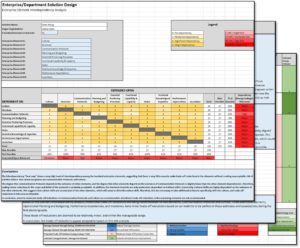Revolutionizing Change Management
Change Management By The Numbers
There is a major deficiency in our traditional change management models and strategies. This deficiency dooms to failure many, if not most, change initiatives – before they even get started. So what have we been missing? The answer: Design.
How we design our organizational solutions can make or break our ability to implement them.
Traditional change management models tend to make the assumption that whatever the change is, and however it is designed, it is fine. In effect, the “new solution” serves only as a starting point for the application of a traditional change management model. These traditional models essentially layer educational and motivational activities on top of what is often a flawed organizational solution.
So why does the design of an organizational solution have so much impact on our ability to successfully implement it? The answer lies in a new approach to change management.
A New Approach
This new approach first debuted in Greg Baker’s recently released book, The Energy Equation: Unlocking the Hidden Power of Energy in Business. It’s based on the recognition that at the heart of change, and everything else we do in business, is energy.
Energy is the currency of business, and in the case of change management, keeping track of energy is how we keep score.
Keeping score is based on three primary truths:
- Behavior change, which is the measure of success, is about a shift in energy in the business environment and among the involved people.
- Change happens successfully when you have enough energy pointed in the right direction for long enough to reach the point of sustainable change.
- Change initiatives fail for only one reason – they run out of energy before they reach the finish line – the point of sustainable change.
Keeping score is about tracking how much energy is available to move the change initiative in the desired direction vs. the amount of “energy leakage” resulting in undesirable behaviors. The undesirable behaviors, (i.e., negative energy), push back on the change – typically back toward the status quo.
The reason the design of an organizational solution has so much impact on our ability to successfully implement it is that the components of the solution and how they’re designed have a huge impact on the energy of the change, both positive and negative.
Our traditional change management norms suggest that managers are doing the right thing by managing scope, cost and schedule. Unfortunately, that is typically done at the expense of the solution. This traditional thinking assumes we can make scope cuts without significantly jeopardizing the initiative’s probability of success. Unfortunately, solution scope reductions, and solutions that are poorly designed in the first place, often doom change initiatives to failure.
Crippled solutions drag the change down.
That’s why we’ve developed a better way to design and manage change. But don’t take our word for it, go ahead and see for yourself.
Get Started
If you like to do it yourself, see the sidebar. You will find information on self-paced training and our new change management toolset. This is an amazing offer. If you’re the type that likes a little help, please contact us to set up an introductory consultation.

